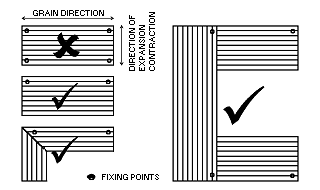INSTALLATION GLULAM BENCHTOPS GUIDE | DGI
Correct installation of DGI GLULAM benchtops is vital for optimum performance. DGI ensures that the timber used in the manufacture of DGI GLULAM has been properly kiln dried to 12%; This is the Equilibrium Moisture Content of dry timber in Australia.
The moisture content of timber will vary due to the movement of moisture into and out of the timber. Natural humidity (dry and wet), air conditioning, machines that dispel heat or moisture (eg. dishwashers, cooking appliances etc.) will effect the moisture content of timber. As moisture in the air increases it is absorbed by the timber and the timber will expand. The timber contracts as moisture in the air decreases.
DGI GLULAM, being a natural timber product, will expand and contract across the grain with these changes in humidity. This movement is quite normal. It is usually only minimal and can be allowed for in the installation (see Figure 3).
Sealing
Good sealing is essential to prevent an abrupt and excessive moisture movement to and from the timber. DGI GLULAM must be envelope sealed ie. top, bottom, edges and ends. Pay particular attention to the inside of cutouts especially the end grain. If you cut on site – reseal the cut area with at least four coats of sealer.
Fixing Positions
Minimal fixing only is required as the piece will be held down by self weight, plumbing etc.. Ideally, fix into the same strip of timber.
The following diagrams show examples of correct & incorrect fixing.

Screw Holes
Fixing through framework into the underside of bench should be via a 12mm clearance hole and an 8 gauge screw with washer, allowing movement between fixing points. Holes should be pre-drilled.

Note: Ensure screw is centralised within clearance hole.
“DGI GLULAM” TOPS SHOULD NEVER BE GLUED DOWN
Service Conditions
DGI GLULAM tops are suitable for interior use only.
- Dishwashers, floor mounted vents & hot water systems.
- Where Appliances have heat acting on the benchtop, polystyrene or similar insulation should be installed to cut down heat transference. Provide adequate ventilation.
- Sinks, cooktops, cutouts for posts etc.
- The fitting of sinks, basins, cooktops etc. must not restrict the benchtop from expanding and contracting. Ensure that there is at least 5mm clearance all around the appliance. Insulation should be installed around cooktops. Rubberised joint sealant should be used in sink and basin applications.
Vegetable storage.- Where vegetables or other material that are likely to give off moisture are stored under the benchtop, insulation should be installed and adequate ventilation provided.
Ventilation.- Particle board or MDF tops fixed to cabinets should be removed or have large holes cut into them to assist with even & adequate ventilation.
Brick walls.- A moisture barrier such as plastic should be utilised in situations where “DGI GLULAM” is located adjacent to brickwork or rendered walls to prevent moisture transference. A slight air gap should also be left.
Overhangs.- If overhangs exceed 200mm then some form of bracketing should be used for support.
Wide tops & stair landings.- With wide tops and stair landings, expansion and contraction is directly proportional to the width: therefore sealing, fixing to allow movement, allowances for moisture and heat are even more important.
External use.- Although DGI GLULAM has been glued with waterproof or highly moisture resistant glues, it is not really designed for exterior use.
To ensure optimum performance, DGI GLULAM requires protection from the environment by means of seal coatings. Sunlight breaks down most coatings, exposing the timber and allowing moisture, humidity and heat to act.
If DGI GLULAM has to be used in external situations the maintenance of the seal coats become even more critical. If surface looks worn or bare then recoating should be done immediately.
Common types of seal coatings are:
- Exterior paint – definitely the best as the finish is slow to break down.
- Clear Polyurethane – even coatings with UV inhibitors break down and flake. Requires full sanding and recoating at least every 12-18 months.
- Exterior oil finish – does not last as long but does not flake and is easy to re-apply. Recoat at least every 9-12 months.
